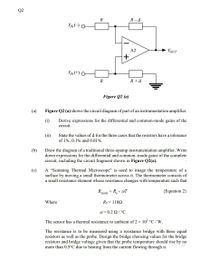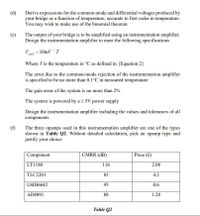
Introductory Circuit Analysis (13th Edition)
13th Edition
ISBN: 9780133923605
Author: Robert L. Boylestad
Publisher: PEARSON
expand_more
expand_more
format_list_bulleted
Question

Transcribed Image Text:Q2
R
R- A
VIN(-)
A2
VOUT
VIN(+)
R
R+ 4
Figure Q2 (a)
(a)
Figure Q2 (a) shows the circuit diagram of part of an instrumentation amplifier.
(i)
Derive expressions for the differential and common-mode gains of the
circuit.
(ii)
State the values of 4 for the three cases that the resistors have a tolerance
of 1%, 0.1% and 0.01%.
(b)
Draw the diagram of a traditional three-opamp instrumentation amplifier. Write
down expressions for the differential and common-mode gains of the complete
circuit, including the circuit fragment shown in Figure Q2(a).
A “Scanning Thermal Microscope" is used to image the temperature of a
surface by moving a small thermometer across it. The thermometer consists of
a small resistance element whose resistance changes with temperature such that
(c)
R-
RSTHM
+ aT
{Equation 2}
Where
Ro = 1102
α- 0.2 Ω/ C
The sensor has a thermal resistance to ambient of 2 x 105 °C / W.
The resistance is to be measured using a resistance bridge with three equal
resistors as well as the probe. Design the bridge choosing values for the bridge
resistors and bridge voltage given that the probe temperature should rise by no
more than 0.5°C due to heating from the current flowing through it.

Transcribed Image Text:(d)
Derive expressions for the common mode and differential voltages produced by
your bridge as a function of temperature, accurate to first order in temperature.
You may wish to make use of the binomial theorem
(e)
The output of your bridge is to be amplified using an instrumentation amplifier.
Design the instrumentation amplifier to meet the following specifications
Vour = 10mV ´T
Where Tis the temperature in °C as defined in {Equation 2}
The error due to the common-mode rejection of the instrumentation amplifier
is specified to be no more than 0.1°C in measured temperature
The gain error of the system is no more than 2%
The system is powered by a + 5V power supply
Design the instrumentation amplifier including the values and tolerances of all
components.
(f)
The three opamps used in this instrumentation amplifier are one of the types
shown in Table Q2. Without detailed calculation, pick an opamp type and
justify your choice
Component
CMRR (dB)
Price (£)
LT1180
116
2.08
TLC2201
85
4.2
LMH6642
95
0.6
AD8091
88
1.28
Table Q2
Expert Solution
This question has been solved!
Explore an expertly crafted, step-by-step solution for a thorough understanding of key concepts.
Step by stepSolved in 3 steps with 3 images

Knowledge Booster
Learn more about
Need a deep-dive on the concept behind this application? Look no further. Learn more about this topic, electrical-engineering and related others by exploring similar questions and additional content below.Recommended textbooks for you
 Introductory Circuit Analysis (13th Edition)Electrical EngineeringISBN:9780133923605Author:Robert L. BoylestadPublisher:PEARSON
Introductory Circuit Analysis (13th Edition)Electrical EngineeringISBN:9780133923605Author:Robert L. BoylestadPublisher:PEARSON Delmar's Standard Textbook Of ElectricityElectrical EngineeringISBN:9781337900348Author:Stephen L. HermanPublisher:Cengage Learning
Delmar's Standard Textbook Of ElectricityElectrical EngineeringISBN:9781337900348Author:Stephen L. HermanPublisher:Cengage Learning Programmable Logic ControllersElectrical EngineeringISBN:9780073373843Author:Frank D. PetruzellaPublisher:McGraw-Hill Education
Programmable Logic ControllersElectrical EngineeringISBN:9780073373843Author:Frank D. PetruzellaPublisher:McGraw-Hill Education Fundamentals of Electric CircuitsElectrical EngineeringISBN:9780078028229Author:Charles K Alexander, Matthew SadikuPublisher:McGraw-Hill Education
Fundamentals of Electric CircuitsElectrical EngineeringISBN:9780078028229Author:Charles K Alexander, Matthew SadikuPublisher:McGraw-Hill Education Electric Circuits. (11th Edition)Electrical EngineeringISBN:9780134746968Author:James W. Nilsson, Susan RiedelPublisher:PEARSON
Electric Circuits. (11th Edition)Electrical EngineeringISBN:9780134746968Author:James W. Nilsson, Susan RiedelPublisher:PEARSON Engineering ElectromagneticsElectrical EngineeringISBN:9780078028151Author:Hayt, William H. (william Hart), Jr, BUCK, John A.Publisher:Mcgraw-hill Education,
Engineering ElectromagneticsElectrical EngineeringISBN:9780078028151Author:Hayt, William H. (william Hart), Jr, BUCK, John A.Publisher:Mcgraw-hill Education,

Introductory Circuit Analysis (13th Edition)
Electrical Engineering
ISBN:9780133923605
Author:Robert L. Boylestad
Publisher:PEARSON

Delmar's Standard Textbook Of Electricity
Electrical Engineering
ISBN:9781337900348
Author:Stephen L. Herman
Publisher:Cengage Learning

Programmable Logic Controllers
Electrical Engineering
ISBN:9780073373843
Author:Frank D. Petruzella
Publisher:McGraw-Hill Education

Fundamentals of Electric Circuits
Electrical Engineering
ISBN:9780078028229
Author:Charles K Alexander, Matthew Sadiku
Publisher:McGraw-Hill Education

Electric Circuits. (11th Edition)
Electrical Engineering
ISBN:9780134746968
Author:James W. Nilsson, Susan Riedel
Publisher:PEARSON

Engineering Electromagnetics
Electrical Engineering
ISBN:9780078028151
Author:Hayt, William H. (william Hart), Jr, BUCK, John A.
Publisher:Mcgraw-hill Education,